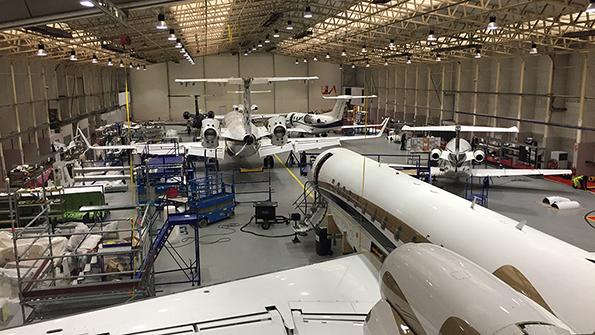
The European Commission’s (EC) April 29 announcement of a six-month delay for aircraft to comply with its Surveillance Performance and Interoperability regulations came as a relief to some operators of business jets.
Aircraft built before Dec. 7, 2020, now have until June 7, 2023, to be fitted with ADS-B (automatic dependent surveillance-broadcast) equipment, provided their operators have established a retrofit compliance program by Dec. 7.
The postponement, made because it was believed operators might not be able to get work done during the COVID-19 crisis, marks the third time the EC has altered the deadline for ADS-B installation. While operators struggling to meet the original deadline will welcome the extra time, the move has deepened concern in certain quarters of the industry.
“When we talk about a topic like ADS-B, there’s much varied opinion,” says Alan Barnes, head of customer support at the London Stansted Airport-based Inflite The Jet Centre. “Large-fleet AOC-type (air operator certificate) operators understand this subject and why they need to do the work, and when they’re going to do it. They budget and they plan. And then you’ve got the guy who owns and flies the aircraft himself, and maybe he’s not so prepared. That’s where the problems arise for the MRO.”
Barnes describes a situation in which an operator might expect almost instant availability of equipment for an ADS-B installation, and capacity within a maintenance facility to be able to carry out the work on short notice. Neither scenario is likely to be realistic.
“We need, effectively, somewhere in the region of 3-6 months to plan,” he says. “We need to get all the service bulletins effective to that serial number of airplane to get the supply chain spooled up, get the avionic OEMs geared up to secure the slots for the LRUs (line-replaceable units) going into shops to be modified.”
The COVID-19 crisis may have prompted the EC’s decision to delay the compliance deadline, but it has only exacerbated the problems MRO shops like Inflite are having with late-notice requests from customers. Some owners are assuming a jet grounded by COVID-related travel restrictions can be booked for ADS-B work on short notice.
The impact of non-compliance will not just be felt with directly caused restrictions on operations, but on the indirect problems an owner will suffer by not upgrading underlying avionic systems.
“Let’s talk about the Embraer Legacy 600,” says Barnes. “It’s a perfect example because generally speaking, the Legacy 600 fleet is now approximately midlife. With ATC changes and navigational changes, it’s now time to move to a new era of avionics and a new era of navigation. And airplanes like the Legacy 600 don’t have the baseline avionic architecture to allow that to happen. So the upgrade pathway is far bigger than just ADS-B: You’ve got to lay the foundation in the airplane to be able to receive the ADS-B modification.”
Continuing, Barnes says, “You might have a customer say, ‘Oh, I don’t need to do ADS-B. My chief pilot said we don’t need it.’ OK, but what you fail to realize is you will also not get things like RNAV (area navigation) and LPV (localizer performance with vertical guidance). These things allow you to go into places like Cannes [France] regardless of ADS-B. So, we’re lifting the aircraft to a new baseline to make it receptive to ADS-B, and we’re bringing the whole avionics architecture of the airplane into the modern era—and that point is often missed.”
Another issue is the rescheduling of the European mandate potentially encourages owners reluctant to arrange for the work to believe further delay is a reasonable option. ADS-B compliance is rarely still an issue for any aircraft flying internationally, but owners who only fly within a single territory may have held back for cost reasons.
“The heavies [jets] in the business-aviation sector are already fitted,” says Joe Gallo, director of marketing for Collins Aerospace’s avionics division. “They’re flying globally and have to be prepared for wherever their principal would like to go, so they’re already compliant. It’s the mids and the lights that are reluctant.”
This trend has been amplified in Europe because ADS-B capabilities will need ground systems that, for the most part, are not yet in place, Gallo points out.
“The problem in Europe has never been the operators generally, but the ground infrastructure,” he explains. “Unlike the United States, or even Australia, where there is significant ground infrastructure in place, that doesn’t exist in Europe and it’s been slow to develop. So the operators have been reluctant to upgrade their aircraft when the ground system isn’t available.”
Nevertheless, avionics suppliers and MRO houses are expecting some owners will use the postponement to push back their own timetables for compliance.
“The theory for many of these operators tends to be, ‘Give me the date, and I’ll wait until three months ahead of time to go and get it done’,” Gallo says. “We typically see a group of operators that slip past the date slightly. Usually, as long as they have a plan for compliance, it gets sorted out. It’ll get done but they’ll just end up waiting until almost the deadline.”
